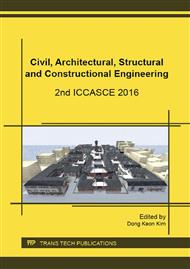p.67
p.73
p.81
p.86
p.91
p.98
p.104
p.111
p.119
Behaviors of Xiashu Loess in the Lower Reaches of China’s Yangtze River under Triaxial Compression and the Microscopic Explanations
Abstract:
To investigate the macroscopic mechanical properties of undisturbed structural Xiashu loess in the lower reaches of China’s Yangtze River under triaxial compression, and obtain the intrinsic explanations for the macroscopic mechanical properties from the microscopic point of view, in laboratory, triaxial compression tests were carried out, microstructure images of sheared samples were collected by scanning electron microscope (SEM), and quantitative parameters of microstructure (mainly about particle or pore size, distribution, and alignment) were extracted by digital image processing technique. Based on the test results, the deviator stress-strain relationships of both undisturbed and remoulded Xiashu loess, the structural strength, and the microstructural evolution mechanism about the formation of shear failure zone of Xiashu loess under triaxial compression were analyzed.
Info:
Periodical:
Pages:
91-97
Citation:
Online since:
November 2016
Authors:
Price:
Сopyright:
© 2017 Trans Tech Publications Ltd. All Rights Reserved
Share:
Citation:


